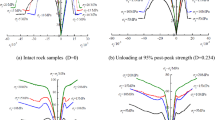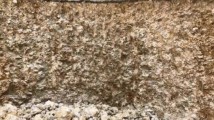Abstract
Fractures in rock mass provide the dominant role in its mechanical properties. In this paper, an in situ experiment is carried out to investigate the specific energy of rock mass, from which the response of the specific energy on the open and in-filled fractures is analysed. The effect of the intact core and the open and in-filled fractures on the specific energy is studied, presenting the link between the fracture frequency and the specific energy. The result shows that the relationship between the fracture frequency and the specific energy is proposed for evaluating the fracture frequency and rock quality designation (RQD). A standard deviation of 0.18 for the specific energy can be used as a critical point to distinguish between the segment of the intact core and the fracture segment. A new prediction method is proposed to determinate the fracture frequency and RQD of rock mass, and its utilization for RQD prediction can overcome the limitations of the original RQD. This method is applied in the water conservancy project and demonstrated to be reliable and accurate by comparative studies with previous work, thus providing a low-cost and simple approach for rock quality evaluation.














Similar content being viewed by others
Abbreviations
- M :
-
torque (N·m)
- w :
-
rotation speed (rpd)
- F :
-
drilling force (N)
- e :
-
specific energy (N/mm2)
- v :
-
Penetration rate (mm/min)
- A :
-
excavation area (mm2)
- f :
-
standard deviation of the specific energy
- s min :
-
minimum value of the standard deviation
- s max :
-
maximum value of the standard deviation
- λ :
-
Fracture frequency
- N :
-
fracture sets number
- λ i :
-
fracture frequency normal to set i
- θ i :
-
fracture orientation
- t :
-
selected threshold value
- ζ :
-
fitting parameter of relationship curve between the fracture frequency and the standard deviation of specific energy
References
Araghi MS, Samani FB, Goudarzi MT. (2006) A proposal for the modification of RQD (MRQD). In: Proceeding of 4th Asian Rock Mechanics Symposium, Rock Mechanics in Underground Construction. ISRM International Symposium
Aydan Ö, Dalgic S. (1998) Prediction of deformation behavior of 3-lanes Bolu tunnels through squeezing rocks of North Anatolian fault zone (NAFZ). In: Proceedings of Regional Symposium on Sedimentary Rock Engineering, p. 228–233. Taipei, China
Azimian A (2016) A new method for improving the RQD determination of rock core in borehole. Rock Mech Rock Eng 49(4):1559–1566
Barr MV (1984) Instrumented horizontal drilling for tunneling site investigations. Ph.D. thesis, Imperial College of Science and Technology, London, U.K, 1984
Barton N. (1990) Scale effects or sampling bias? In: Proc. Int. Workshop Scale Effects in Rock Masses. 1990. pp 31–55. Balkema Publ., Rotterdam
Barton N (2002) Some new Q-value correlations to assist in site characterization and tunnel design. Int J Rock Mech. Min Sci 39(2):185–216
Barton N, Loset F, Lien R, Lunde J. (1980) Application of Q-system in design decisions. In: Bergman M, editor. Subsurface space, vol 2. Proceedings of the International Symposium, 1980. p. 553–561. 2. Pergamon Press
Bieniawski ZT (1978) Determining rock mass deformability: experience from case histories. Int J Rock Mech Min Sci Geomech Abstr 15(5):237–247
Bieniawski ZT (1989) Engineering rock mass classification: a complete manual for engineers and geologists in mining, civil, and petroleum engineering. Wiley, New York, p 251
Chen JP, Fan JH, Liu D (2005) Review and prospect on the application and research of RQD. Rock Soil Mech 26(S.2):249–252 (in Chinese)
Choi SY, Park HD (2004) Variation of rock quality designation (RQD) with scanline orientation and length: a case study in Korea. Int J Rock Mech Min Sci 41(2):207–221
Coon RF, Merritt AH. (1970) Predicting in situ modulus of deformation using rock quality indexes. In: Determination of the in situ modulus of deformation of rock. 1970. 154-173. ASTM International
Deere DU (1963) Technical description of rock cores for engineering purposes. Rock Mech Eng Geol 1(1):18
Deere DU (1989) Rock quality designation (RQD) after 20 years. US Army Corps of Engineers Contract Report GL-89-1. 1989. 67. Waterways Experiment Station, Vicksburg, MS
Deere DU, Deere DW (1988) The rock quality designation (RQD) index in practice. In: Proceedings of Symposium on Rock Class, Engineering Purposes. 1988. 984, 91–10. ASTM Special Technical Publications
Deere DU, Hendron AJ, Patton FD, Cording EJ (1967) Design of surface and near surface constructions in rock. In: Fairhurst C (ed) Proceedings of 8th US Symposium on Rock Mechanics. AIME, Hack, R, New York, pp 237–302
Elci H, Turk N (2014) Rock mass block quality designation for marble production. Int J Rock Mech Min Sci 69:26–30
Gokceoglu C, Sonmez H, Kayabasi A (2003) Predicting the deformation moduli of rock masses. Int J Rock Mech Min Sci 40(5):701–710
Goodman RE (1993) Engineering geology. Rock in engineering construction. Wiley, New York, p 385
Hack R (2002) Keynote Lecture: an evaluation of slope stability classification. In: Dinis da Gama C, Ribeira e Sousa L (eds) Proceedings of ISRM EUROCK’2002, Portugal, Madeira, Funchal. Sociedade Portuguesa de Geotecnia, Lisboa, pp 3–32
Haftani M, Chehreh HA, Mehinrad A, Binazadeh K (2016) Practical investigations on use of weighted joint density to decrease the limitations of RQD measurements. Rock Mech Rock Eng 49(4):1551–1558
Harrison JP (1999) Selection of the threshold value in RQD assessments. Int J Rock Mech Min Sci 36(5):673–685
Hoek E (1994) Strength of rock and rock masses. News J ISRM 2(2):4–16
Hoek E, Bray JW (1981) Rock slope engineering. revised, 3rd edn. The Institution of Mining and Metallurgy, London
Hoek E, Brown ET (1980) Underground excavations in rock. Institution of Mining and Metallurgy, London
Hoek E, Brown ET (1997) Practical estimates of rock mass strength. Int J Rock Mech Min Sci 34(8):1165–1186
Hoek E, Diederichs MS (2006) Empirical estimation of rock mass modulus. Int J Rock MechMin Sci 43(2):203–215
Jiang R, Dai F, Liu Y, Li A (2021a) Fast marching method for microseismic source location in cavern containing rockmass: performance analysis and engineering application. Engineering. Available online 21 January 2021. https://doi.org/10.1016/j.eng.2020.10.019
Jiang R, Dai F, Liu Y, Li A, Feng P (2021b) Frequency characteristics of acoustic emissions induced by crack propagation in rock tensile fracture. Rock Mech Rock Eng. Published February 2021. https://doi.org/10.1007/s00603-020-02351-5
Li L, Ouellet S, Aubertin M. (2009) An improved definition of rock quality designation, RQDc. In: Proceedings of the 3rd CANUS Rock Mechanics Symposium, Toronto, May. 2009
Mitri HS, Edrissi R, Henning J. (1994) Finite element modeling of cablebolted stopes in hard rock ground mines. Presented at the SME Annual Meeting. 94–116. Albuquerque, USA. 1994
Nicholson GA, Bieniawski ZT (1980) A nonlinear deformation modulus based on rock mass classification. Int J Min Geol Eng 8(3):181–202
Palmstrom A (1982) The volumetric joint count—a useful and simple measure of the degree of jointing. In: Proceedings of international congress of IAEG, 221–228. New Delhi
Palmstrom A. (1985) Application of the volumetric joint count as a measure of rock mass jointing. Proc. Int. Symp. on Fundamentals of Rock Joints, 1985. 103–110. Bjorkliden
Palmstrom A (1986) A general practical method for identification of rock masses to be applied in evaluation of rock mass stability conditions and TBM boring progress. In: Proc. Conf. on Fjellsprengingsteknikk, Bergmekanikk. Geoteknikk, Oslo, Norway, 1986; 31.1–31.31
Palmstrom A. (1995) RMi—a rock mass characterization system for rock engineering purposes. PhD thesis, University of Oslo, Department of Geology. 1995
Palmstrom A (2005) Measurements of and correlations between block size and rock quality designation (RQD). Tunnels Undergr Space Technol 20:362–377
Pfister P (1985) Recording drilling parameters in ground engineering. Geodri Uing 10:8–13
Priest SD (1993) Discontinuity analysis for rock engineering. Chapman & Hall, London
Priest SD, Hudson JA (1976) Discontinuity spacings in rock. Int J Mech Min Sci Geomech Abstr 13:135–148
Schunnesson H (1990) Drill process monitoring in percussive drilling--a multivariate approach to data analysis. Licentiate thesis 1990:08L, Lule University of Technology. 1990
Schunnesson H (1996) RQD predictions based on drill performance parameters. Tunn Underg sp Tech 11(3):345–351
Scoble MJ, Peck J (1987) A technique for ground characterization using automated production drill monitoring. Int J Surf Mining 1:41–54
Sen Z (1990) Cumulative core index for rock quality evaluations. Int J Rock Mech Min Sci Geomech Abstr 27(2):87–94
Sen Z (1993) RQD-fracture frequency chart based on a Weibull distribution. Int J Mech Min Sci Geomech Abstr 30(5):555–567
Sen Z, Eissa EA (1992) Rock quality charts for long—normally distributed block size. Int J Rock Mech Min Sci Geomech Abstr 29(1):1–12
Sen Z, Kazi A (1984) Discontinuity spacing and RQD estimates from finite length scanlines. Int J Mech Min Sci Geomech Abstr 21(4):203–212
Serafim JL, Pereira JP (1983) Consideration of the geomechanical classification of Bieniawski. In: Proceedings of International Symposium on Engineering Geology and Underground Construction, vol. 1. 3–44. Rotterdam: A.A. Balkema. 1983
Sheorey PR (1997) Empirical rock failure criteria. A.A. Balkema, Rotterdam
Teale R (1965) The concept of specific energy in rock drilling. Int J Rock Mech Min Sci 2:57–73
Wang Q, Gao S, Li S, He M, Gao H, Jiang B, Jiang Y (2018a) Upper bound analytic mechanics model for rock cutting and its application in field testing. Tunnel Undergr Sp Tech 73:287–294
Wang Q, Gao S, Jiang B, Li S, He M, Gao H, Qin Q (2018b) Rock-cutting mechanics model and its application based on slip-line theory. Int J Geomech 18(5):04018025
Wang Q, Gao HK, Yu HC, Jiang B, Liu BH (2019) Method for measuring rock mass characteristics and evaluating the grouting-reinforced effect based on digital drilling. Rock Mech Rock Eng 52:841–851
Yudhbir WL, Prinzl F (1983) An empirical failure criterion for rock masses. In: Proceedings of the 5th International Congress on Rock Mechanics, 1: B1–8. Melbourne. 1983
Yue ZQ, Lee CF, Law KT, Tham LG (2004) Automatic monitoring of rotary-percussive drilling for ground characterization-illustrated by a case example in Hong Kong. Int J Rock Mech Min Sci 41(4):573–612
Zhang L (2010) Estimating the strength of jointed rock masses. Rock Mech Rock Eng 43(4):391–402
Zhang L, Einstein HH (2004) Using RQD to estimate the deformation modulus of rock masses. Int J Rock Mech Min Sci 41(2):337–341
Zheng J, Yang XJ, Lü Q, Zhao Y, Deng JH, Ding ZJ (2018) A new perspective for the directivity of Rock Quality Designation (RQD) and an anisotropy index of jointing degree for rock masses. Eng Geol 240:81–94
Zheng J, Wang X, Lü Q, Liu J, Guo J, Liu T, Deng J (2020) A contribution to relationship between volumetric joint count (Jv) and rock quality designation (RQD) in three-dimensional (3-D) space. Rock Mech Rock Eng 53(3):1485–1494
Funding
This study is sponsored by the National Natural Science Foundation of China (Grants Nos. 11902249 and 11872301), Natural Science Foundation of Shaanxi Province (Shaanxi Province Natural Science Foundation) (Grant No. 2019JQ395), and Education Bureau of Shaanxi Province | Scientific Research Plan Projects of Shaanxi Education Department in China (Grant No. 20JS093).
Author information
Authors and Affiliations
Corresponding author
Ethics declarations
Competing interests
The authors declare no competing interests.
Additional information
Author information
Reprints and permission information are available. Correspondence and requests for materials should be addressed to M.M. He (hemingming@xaut. edu.cn).
Rights and permissions
About this article
Cite this article
He, M., Zhang, Z. & Li, N. Prediction of fracture frequency and RQD for the fractured rock mass using drilling logging data. Bull Eng Geol Environ 80, 4547–4557 (2021). https://doi.org/10.1007/s10064-021-02240-3
Received:
Accepted:
Published:
Issue Date:
DOI: https://doi.org/10.1007/s10064-021-02240-3




